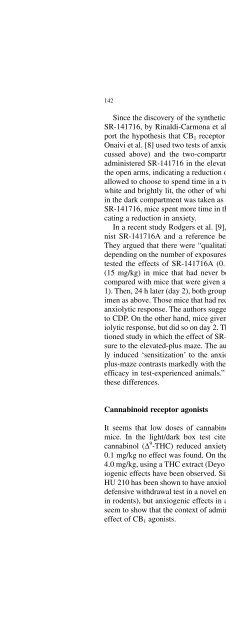3. Umbruch 4.4..2005 - Online Pot
3. Umbruch 4.4..2005 - Online Pot
3. Umbruch 4.4..2005 - Online Pot
Create successful ePaper yourself
Turn your PDF publications into a flip-book with our unique Google optimized e-Paper software.
142 R.E. Musty<br />
Since the discovery of the synthetic, highly potent CB 1 receptor antagonist,<br />
SR-141716, by Rinaldi-Carmona et al. [7] several other studies seem to support<br />
the hypothesis that CB 1 receptor antagonists have anxiolytic properties.<br />
Onaivi et al. [8] used two tests of anxiety in mice, the elevated-plus maze (discussed<br />
above) and the two-compartment black and white box test. When<br />
administered SR-141716 in the elevated-plus maze, mice spent more time in<br />
the open arms, indicating a reduction of anxiety. In the second test, mice were<br />
allowed to choose to spend time in a two-compartment box, one of which was<br />
white and brightly lit, the other of which was black and dimly lit. Time spent<br />
in the dark compartment was taken as an index of anxiety. When administered<br />
SR-141716, mice spent more time in the white, brightly lit compartment, indicating<br />
a reduction in anxiety.<br />
In a recent study Rodgers et al. [9], administered the CB 1 receptor antagonist<br />
SR-141716A and a reference benzodiazepine chlordiazepoxide (CDP).<br />
They argued that there were “qualitative” differences of cannabinoid ligands<br />
depending on the number of exposures (trials) in the elevated-plus maze. They<br />
tested the effects of SR-141716A (0.1–10.0 mg/kg) and the reference CDP<br />
(15 mg/kg) in mice that had never been exposed to the elevated-plus maze<br />
compared with mice that were given an exposure to the maze undrugged (day<br />
1). Then, 24 h later (day 2), both groups of mice were given the same drug regimen<br />
as above. Those mice that had received CDP on day 1 did not exhibit any<br />
anxiolytic response. The authors suggest this indicated an immediate tolerance<br />
to CDP. On the other hand, mice given SR-1411716 on day 1 showed no anxiolytic<br />
response, but did so on day 2. This result is in contrast to the afore-mentioned<br />
study in which the effect of SR-141716 was observed on the first exposure<br />
to the elevated-plus maze. The authors state: “The apparent experientially<br />
induced ‘sensitization’ to the anxiolytic-like effects of SR-141716 in the<br />
plus-maze contrasts markedly with the widely reported loss of benzodiazepine<br />
efficacy in test-experienced animals.” Further research is required to resolve<br />
these differences.<br />
Cannabinoid receptor agonists<br />
It seems that low doses of cannabinoid receptor agonists are anxiolytic in<br />
mice. In the light/dark box test cited above, 0.3 mg/kg of ∆ 9 -tetrahydrocannabinol<br />
(∆ 9 -THC) reduced anxiety [10], but in lower doses of 0.03 and<br />
0.1 mg/kg no effect was found. On the other hand, with doses of 5.0 [10] and<br />
4.0 mg/kg, using a THC extract (Deyo R et al., personal communication), anxiogenic<br />
effects have been observed. Similarly, the potent CB 1 receptor agonist<br />
HU 210 has been shown to have anxiolytic effects at low doses (4 µg/kg) in the<br />
defensive withdrawal test in a novel environment (associated with fear/anxiety<br />
in rodents), but anxiogenic effects in a familiar environment [11]. These data<br />
seem to show that the context of administration is an important variable in the<br />
effect of CB 1 agonists.







